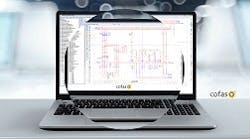ELECTRONIC computer-aided design (ECAD) appears to be commonplace at virtually every machine builder, system integrator, design house and even many high-tech distributors. These and other players in machine automation must have an efficient electronic means of generating documents to compete on a global scale. The issue today is time to market. The quicker accurate documents are in place and materials purchased, the quicker machine construction begins. In essence, ECAD is about time-savings.
Innovations in ECAD now provide a global perspective, with a high emphasis on data management and file transfer communications. At least one supplier can now transport computer-generated design documents in more than 130 languages. Moreover, there appears to be a distinct shift in functionality towards computer-aided engineering (CAE) and away from being just a design package. [Editors note: for more on ECAD, read ECAD Software Eases Electrification.]
Integrating electrical design, with estimating, purchasing, fluid power, plant process engineering, software generation, panel build, machine build, 3-D modeling and even manufacturing are crucial in todays global economy, says Mark Taylor, executive vice president and general manager at EPlan Software and Services.
To reach this goal, Rittal-owned EPlan developed Electric P8, a new product platform on a data management foundation, which incorporates and integrates features across multiple engineering and plant disciplines. Our products are designed to work in a new age of operability, linking data and leveraging design efforts, which allow customers to advance the engineering level, while reducing project completion time, adds Taylor.
Greg Weirauch, marketing communications manager at ECT International, stresses automatic drawing generation as ECTIs latest innovation. Its promis-e ECAD software now includes a Project Builder module. Thomas Noller, manager of controls for automotive paint systems at Eisenmann Corp. in Crystal Lake, Ill., adds, We can generate standardized schematics for an entire system simply by defining circuit variables within an Excel file. The Excel file is loaded into Project Builder, and the hardwire schematics are generated automatically within minutes. These features drastically reduced engineering time, and increased the accuracy of our electrical documentation.
Weirauch adds, Project Builder automatically generates entire sets of project drawings from entries in an Excel file. Advantages for machine builders include speed, consistency, less human errors, and it requires no CAD skills.
Another of ECTIs innovation is its Data Editor mode that allows users to access and edit all of the data from a project in one place. There are tabs for different categories, including text, wire numbers, device IDs, and symbol text. The user can easily search, sort, and edit data, says Weirauch. He adds that Data Editor and Project Builder add to ECTIs global project management capability for machine builders.
In addition, Autodesk Manufacturing Solutions incorporates a complete set of industry-standard symbols, and provides automatic report generation directly from the design, including a panel layout document. The latest version of AutoCAD Electrical 2007 expands the symbol library to include libraries for creating pneumatic, hydraulic and P&ID (adhering to ANSI/ISA S5.1 standards) drawings. Autodesk also emphasizes compatibility with the .dwg drawing format for sharing design files.
AutoCAD Electrical 2007 bridges the gap between electrical and mechanical engineers, says Scott Reese, Autodesks product manager. Designers can now communicate electrical designs bidirectionally between AutoCAD Electrical and Autodesk Inventor Professional.
Also, Autodesks Productstream manages AutoCAD Electricals bills of materials by controlling the release and change of design. Autodesks Vault Integration provides tools for running vault operations on the project, and supports single-user and multi-user environments. In the multi-user environment, the vault folder can be accessed by many users on a shared network resource. It also provides drawing status indicators and better control of project-wide commands.
Autodesk delivers manufacturing solutions that brings electrical and mechanical engineers together, adds Reese. Until now, these two disciplines were forced to collaborate on incompatible systems. Our expanded symbol libraries for creating pneumatic, hydraulic and P&ID drawings enable machine builders to increase productivity, and automate key control system design tasks.
These innovations and others could eventually lead to complete virtual design, build, and machine commissioning before anything is constructed. Interfacing or adding kinematic modeling to eCAD solutions will provide the next major innovation that will dramatically impact machine builders. Even now, signal mapping in a virtual machine control design could lead to an evaluation of machine performance using a kinematic model. As a result, commissioning an entire machine or process before build may not be far off. Certainly, simulation technology is moving briskly in that direction, and well explore that closely later this year.
| About the Author |



